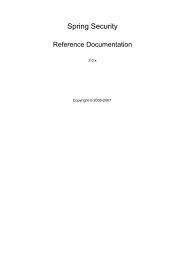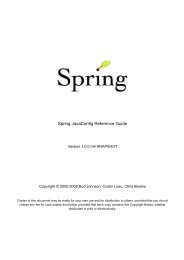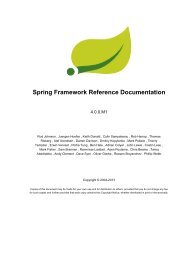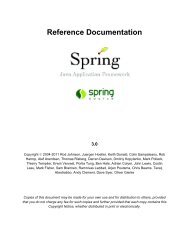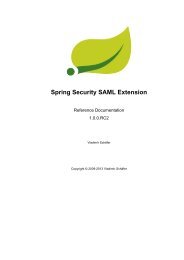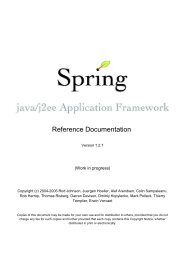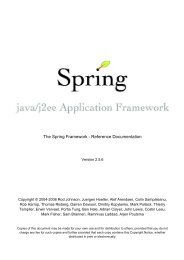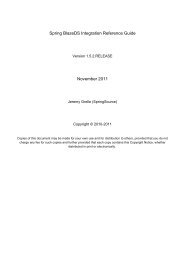Spring Data MongoDB - Spring Web Services - Parent - SpringSource
Spring Data MongoDB - Spring Web Services - Parent - SpringSource
Spring Data MongoDB - Spring Web Services - Parent - SpringSource
You also want an ePaper? Increase the reach of your titles
YUMPU automatically turns print PDFs into web optimized ePapers that Google loves.
Part I. IntroductionThis document is the reference guide for <strong>Spring</strong> <strong>Data</strong> - Document Support. It explains Document moduleconcepts and semantics and the syntax for various stores namespaces.This section provides some basic introduction to <strong>Spring</strong> and Document database. The rest of thedocument refers only to <strong>Spring</strong> <strong>Data</strong> Document features and assumes the user is familiar with documentdatabases such as <strong>MongoDB</strong> and CouchDB as well as <strong>Spring</strong> concepts.1 Knowing <strong>Spring</strong><strong>Spring</strong> <strong>Data</strong> uses <strong>Spring</strong> framework's core functionality, such as the IoC container, type conversionsystem, expression language, JMX integration, and portable DAO exception hierarchy. While it is notimportant to know the <strong>Spring</strong> APIs, understanding the concepts behind them is. At a minimum, the ideabehind IoC should be familiar for whatever IoC container you choose to use.The core functionality of the <strong>MongoDB</strong> and CouchDB support can be used directly, with no need toinvoke the IoC services of the <strong>Spring</strong> Container. This is much like JdbcTemplate which can be used'standalone' without any other services of the <strong>Spring</strong> container. To leverage all the features of <strong>Spring</strong><strong>Data</strong> document, such as the repository support, you will need to configure some parts of the libraryusing <strong>Spring</strong>.To learn more about <strong>Spring</strong>, you can refer to the comprehensive (and sometimes disarming)documentation that explains in detail the <strong>Spring</strong> Framework. There are a lot of articles, blog entries andbooks on the matter - take a look at the <strong>Spring</strong> framework home page for more information.2 Knowing NoSQL and Document databasesNoSQL stores have taken the storage world by storm. It is a vast domain with a plethora of solutions,terms and patterns (to make things worth even the term itself has multiple meanings). While some of theprinciples are common, it is crucial that the user is familiar to some degree with the stores supported byDATADOC. The best way to get acquainted to this solutions is to read their documentation and followtheir examples - it usually doesn't take more then 5-10 minutes to go through them and if you are comingfrom an RDMBS-only background many times these exercises can be an eye opener.The jumping off ground for learning about <strong>MongoDB</strong> is www.mongodb.org. Here is a list of other usefulresources.• The online shell provides a convenient way to interact with a <strong>MongoDB</strong> instance in combination withthe online tutorial.• <strong>MongoDB</strong> Java Language Center• Several books available for purchase• Karl Seguin's online book: "The Little <strong>MongoDB</strong> Book"



